MARKET OVERVIEW
In the Global Virus Filtration market, there exists a highly critical role in several industries with high risks of contamination, especially in healthcare, biotechnology, and pharmaceuticals, in order to prevent viral contamination of biological materials, including vaccines, blood products, or other treatments. As governments across the world introduce increasing regulatory requirements to protect human health, demand for virus filtration technologies would increase and open up new areas of opportunity and challenges for market players.
The Global Virus Filtration market would cover several industries with stringent filtration systems to remove or reduce viruses from products. Major end-users include pharmaceutical companies. These companies will continue to use virus filtration systems to ensure drugs, vaccines, and biologics are free from viral contamination. Blood and plasma centers, which are in common practice related to collecting, processing, and storing human blood products, will also adopt advanced filtration technologies to ensure safety against viral risks. Virus filtration systems will also be helpful to research and development in biotechnology since these technologies are directly related to the assurance of unadulterated experimental samples and therapies.
The Global Virus Filtration market will keep growing with the advent of new, more efficient filtration technologies. Improvements in membrane filtration, nanotechnology, and other novel innovations will assist manufacturers with providing additional more efficient solutions for virus removal. New viruses will emerge and existing ones will continue to mutate, creating a need for more sophisticated systems of filtration. Following this demand, a wide variety of products will flood the markets, each designed for specific viruses or applications.
There is also likely to be strong interest from regions, especially emerging markets in Asia Pacific, the Middle East, and Latin America. With strengthening healthcare systems and regulatory standards, demand for virus filtration products will grow exponentially. Companies will have to adapt their strategies to address diversity in regulatory landscapes and uneven stages of readiness in markets. This could define the overall competitive dynamics of the market.
The market for Global Virus Filtration will be more innovative in terms of awareness regarding safety and prevention of contamination. Manufacturers will look to further improve their product efficiency and reduce cost, which will serve as a source of entry into new market space. In addition, leading technology and healthcare companies' joint ventures will further accelerate the advancement of new and highly developed virus filtration systems.
This is to say that the Global Virus Filtration market will become one of the core areas of business segments in the industries, focusing on the safety of biological materials. It will still grow further with the continuously increasing demand for highly specific filtration solutions resulting from the continuing progress of technology, strengthened regulatory measures, and global health-related issues. This will see the industry continue to struggle and innovate with emerging needs for safe and effective virus filtration, and the market will continue to grow worldwide to support humanity's pursuit of healthy lives and improved biological products.
Global Virus Filtration market is estimated to reach $10,195.8 Million by 2031; growing at a CAGR of 11.9% from 2024 to 2031.
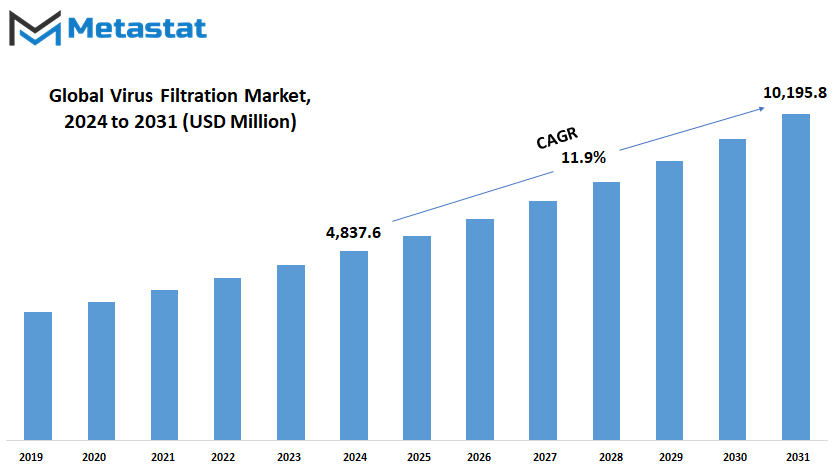
GROWTH FACTORS
The Global Virus Filtration market is expected to witness high growth in the future years, mainly led by various factors indicating the increasing relevance of virus removal in distinct industries. The market primarily grows because the demand for biopharmaceuticals and vaccines is growing. The biopharmaceutical industry is primarily characterized by its growth, and because of this, the expanded need for effective virus filtration technologies is very important. This process of vaccine and biologic production involves a highly complex, biological process, wherein any threat of contamination may expose the viruses to this process and subsequently yield low-quality products. With more candidates for vaccines and increased global demand for life-saving therapies, safety is likely to be at the forefront when it comes to what’s playing a crucial role in ensuring it during production processes.
Elevated awareness of safety and quality during pharmaceutical manufacture is propelling further investment in advanced filtration technologies. The regulatory authority across the world started imposing stricter guidelines to ensure safety and quality of pharmaceutical products. And because of these new regulations, pharmaceutical firms are investing much in modern filtration technologies to ensure that quality products are manufactured according to the demand. So, preventing viral contamination in the drug manufacturing process has increased the demand for virus filtration technology in the pharmaceutical industries, where such technology ensures removal or inactivation of viruses likely to occur either as raw material or during the manufacturing process.
However, there are challenges that may affect the growth of the Global Virus Filtration market. One of these constraints is the high implementation cost of advanced filtration systems and their maintenance cost. Lower manufacturing companies, especially in developing markets, face difficulty in adopting expensive technologies due to their limited budget. These systems require a significant investment upfront and cost money to maintain and operate, hence they are out of reach for some companies. Technical complexity in achieving the desired virus reduction level is another hindrance. Biological matrices applied in biopharmaceutical production are of a great diversity and complexity of composition, thus making consistent and effective virus filtration very challenging.
Despite these challenges, innovation in filtration technology offers tremendous opportunities for growth in the near future. Efficiency enhancements, lower operating costs, and alternative filtration materials and techniques will make the virus filtration system more affordable for more manufacturers or business houses. These might make technological systems more achievable for smaller manufacturers and lead to increased penetration into the market. The following would be foreseen in the future: An added focus on safety, quality, and efficiency would typically push in the future toward an advancement of the type of solution that could respond to the increasing demand for virus filtration across industry sectors.
MARKET SEGMENTATION
By Technology
The Global Virus Filtration market is poised to expand at a considerable pace in the next few years due to the robust demand for efficient virus filtration products in various industries. These products are critical to ensure product safety and quality, particularly within the health care, biotechnology, and pharmaceutical industries. Virus filtration technologies have emerged as an effective approach for preventing contamination, ensuring higher product safety that consumers use globally.
The Global Virus Filtration market can be segmented by technology into several key technologies. These have different advantages, depending on the nature of the virus and application. Membrane filtration is one of the more widespread methods. Here, particles like viruses are separated from liquids or gases by a semi-permeable membrane. It is thus very effective in several areas, such as water treatment and pharmaceutical manufacturing, where a virus with pathogenic potential needs to be ruled out.
The other key technology is depth filtration. It works by passing contaminated liquids through a porous medium with the role of separating the contaminants. Unlike membrane filtration, depth filtration can entrap larger particles, thus being useful in applications such as viruses in difficult mixtures of contaminants. This method is drawing growing attention in biotech and pharmaceutical with the capability of removing both larger and smaller particles from liquids.
Ultrafiltration and nanofiltration belong to the advanced filtration techniques. Ultrafiltration is a process using fine membranes which can filter out many viruses, bacteria, and other particles based on certain size-specific properties. Such a process has become inevitable in biotechnology and medical fields, especially for the production of vaccines and biological products. It targets even smaller particles than ultrafiltration and is becoming more common in water treatment and the pharmaceutical industries, where critical filtering of the smallest viruses must take place.
The other leading technology in the Global Virus Filtration market is microfiltration. It filters out comparatively larger contaminants and is quite commonly used in food and beverage production industries that filter relatively larger particles. While it may not be very effective for smaller viruses, microfiltration remains an important tool in many industrial applications.
Virus inactivation is one of the most crucial methods in this market. In this process, a virus is either killed by chemicals, irradiation, or heat so that the treatment products become safe. This process is particularly crucial for vaccines and blood products and other medical applications.
Adsorption-based filtration, a fairly new technology that works based on the capture of viruses and other contaminants onto a surface. It is one of those newer technologies with a huge prospect of being very effective in various applications, from pharmaceutical to water treatment.
In the years to come, demand for high-quality virus-free products will continue to push the development of these technologies so that each method becomes more special and efficient for its intended application. More industries will realize their need for strict safety measures and employ filtration technologies.
By Application
The Global Virus Filtration market is also expected to grow with a very high growth rate in the coming years because there is a tremendous demand for safety and efficiency in all industries. As people become increasingly worried about viral contamination and health risks, the industries are targeting putting virus filtration systems in place to ensure that their products and processes are safe. Manufacturing pharmaceutical and biopharmaceutical products, water and wastewater treatment, blood and blood product processing, food and beverage processing, air filtration in cleanrooms, laboratory filtration, and vaccine production rely on these filtration systems. The market shall grow.
It involves the removal of viruses as contaminants that may bring together alterations in either the safety and quality of medicines or therapies during drug preparation processes in pharmaceutical and biopharmaceutical manufacturing. With the tremendous growth occurring within the area of biopharmaceutical research, the need for virus-free products keeps surging, especially in the sphere of vaccine, biologics, and medicinal therapies. As drug manufacturers pursue perfect purity standards and security in products, there will be an increased demand for virus filtration systems.
Water and wastewater treatment is another major application area for virus filtration. In reality, the increased fear of water-borne diseases and contaminants is actually compelling implementation of virus filtration systems in this industry. In tandem with the improvement of global standards of water quality, removing viruses from water and wastewater will become a key need. This will be a significant driver for filtration technologies capable of removing dangerous viruses and bacteria from water supplies.
Blood and blood product processing also needs virus filtration systems to ensure that blood donated and blood products are safe. The concern with donors becoming increasingly infected with bloodborne diseases makes the prevention of contamination during blood processing more stringent. Virus filtration will remain an important aspect in keeping blood donations all over the world safe and of good quality.
Virus filtration shall prove highly instrumental in establishing safety in the food and beverage industry, especially during processing and packaging. Food and beverage organizations shall be compelled to include virus filtration systems in their production to ensure that their products are not contaminated and meet the standards required in food safety. This shall be of paramount importance especially while processing raw materials as well as ensuring the safety of packaged products.
Air filtration in cleanrooms will be critical for industries like biotechnology and semiconductor manufacturing, as these industries require controlled environments. Virus filtration systems are therefore key factors to ensure that viral contamination does not occur in this vulnerable environment of the cleanroom setting.
Laboratory filtration will also increase as laboratories continue to improve the safety of their research and testing processes. Virus filtration systems will be important in helping ensure that viruses do not interfere with experiments or contaminate research materials.
Vaccine production will be one of the major market drivers for growth in the global virus filtration market. With a greater need for vaccines, particularly at times of global health emergencies, there will be a need for sophisticated filtration systems to ensure that viruses are eliminated from the production process. Advanced vaccine development will be dependent on virus filtration technology to produce safe, effective vaccines.
The future of Global Virus Filtration will be bright in this market. The systems serving to protect public health and enhance standards for safety will continue to see increased demand across various industries. The world would slowly adapt to the virus filtration system, as regulation and health concerns are what drive innovation.
By End User
The Global Virus Filtration market is growing very fast, mainly because of the increasing demand for solutions meant to protect against viral contamination in a wide array of industries. This market will continue growing since more industries are now seeking safe virus filtration methods to ensure quality. The world is slowly becoming more conscious of health and safety, and thus, its demand for advanced filtration technologies will keep growing.
However, the other significant segment of the market is based on end user. In fact, Pharmaceutical Companies, Biotech firms, and their research labs, hospitals and other clinical settings rely largely upon virus filtration systems to protect their products, research, and patient care. On top of this, pharmaceutical firms use the said product to have a pure drug formulation, so that viruses cannot get contaminated during its manufacture or packing period. Similar examples can be observed in the case of biotech companies, which, through virus filtration, do not allow their biologics from getting contaminated to a great extent, impacting the safety and efficacy of such products.
Other major participants in the Global Virus Filtration market are research laboratories. As vaccines and other therapeutic products continue to be developed, virus-free environments ensure the accuracy and reliability of research outputs. The use of virus filtration technology within these laboratories prevents contamination from viruses which could render experimental results invalid or compromise some life-saving treatments.
Hospitals and clinical laboratories are increasingly adopting virus filtration systems as part of the general effort to better deliver patient care through infection disease reduction. In these premises, medical instruments, air, and liquids need to be sterilized free of viruses harmful to patients. This could also increase demand for virus filtration in such facilities as the pressure mounts on the hospitals to maintain higher levels of cleanliness and safety standards.
Virus filtration is a critical aspect in the water treatment industry as harmful microorganisms will be removed from both drinking water and wastewater, and the issue of waterborne diseases is also surfacing around the globe. Water treatment facilities would continue to invest in virus filtration systems to ensure water safety for consumption or other uses, further boosting the demand in that sector.
The virus filtration also benefits the food and beverages manufacturers who want to ensure that their products remain safe and of high quality. Contamination in food and beverages might cause health hazards and be recalled, thus these companies are implementing the filtration systems in their production lines.
Contract Manufacturing Organizations are the final type of end-user in the Global Virus Filtration market. CMOs typically take on the production of drugs and biotech companies, which require high grade, and thus utilize virus filtration technology as the end solution to prevent contamination from occurring in the manufacturing process. Given the increasing trend of outsourced production, CMO will continue to innovate virus filtration as a core component of their operations.
Looking ahead, demand for virus filtration will continue to grow, influenced primarily by technological advancement and heightened awareness of the risks of viral contamination. The Global Virus Filtration market is placed on a trajectory of continued growth as such industries continue to depend on filtration systems that help in attaining safety, quality, and health.
|
Report Coverage |
Details |
|
Forecast Period |
2024-2031 |
|
Market Size in 2024 |
$4,837.6 Million |
|
Market Size by 2031 |
$10,195.8 Million |
|
Growth Rate from 2024 to 2031 |
11.9% |
|
Base Year |
2022 |
|
Regions Covered |
North America, Europe, Asia-Pacific Green, South America, Middle East & Africa |
REGIONAL ANALYSIS
The market is experiencing rapid growth because of the rising concern regarding viral contamination in many industries, including health care, biotechnology, and pharmaceuticals. The market is witnessing an increasing trend in demand for efficient filtration technologies, and it is consistently moving towards developing advance and specialized filtration solutions. Well, in the future, it would be easily noticeable that the market was bound to grow as different regions across the market were going to grow at some pattern, and challenges were to be faced at various levels.
Geography-wise, the global virus filtration market can be categorized as a few key geographies: North America, Europe, Asia-Pacific, South America, and Middle East & Africa. Each of the regions is important in forming up the dynamics of the market. North America, which comprises the U.S., Canada, and Mexico, is likely to remain at the top of the chain, mainly due to strong healthcare infrastructure and surging demand for virus filtration across the pharmaceutical and biotechnology industries. The U.S. remains at the top of the chain due to its advanced medical research capabilities and has strict regulatory standards that would require more advanced virus filtration systems for different applications.
In Europe, countries such as the UK, Germany, France, and Italy are aggressively investing in biotechnology and life sciences, which will most likely take the market further in this region. The European governments are also implementing more stringent healthcare and standards on safety regulations, which in turn will increase demand for reliable filtration systems to eliminate viral contaminants. Furthermore, in the absence of a reduction in the bio-nanotechnology, emphasis, and focus in the region, only the demand for effective filtration solutions will increase.
The Asia-Pacific region, which covers India, China, Japan, and South Korea, also holds a potential for strong growth. Increased manufacturing activities, especially of pharmaceutical and biotechnology products, shall raise the demand of these systems. The newer healthcare technologies implemented by the countries such as China and Japan, among others, lead to prospective increase in the market across this region. This will be further boosted by the developing health care industries in both India and South Korea, which will raise the demand for virus filtration solutions.
In South America, there are Brazil and Argentina with growing healthcare and pharmaceutical investments, therefore a potential growing market for virus filtration products. Still in the early stages of growth compared to other regions, South America, however, has potential for future growth especially with an increasing demand for clean and safe healthcare environments.
Steady growth is also expected in Middle East & Africa, which comprises GCC countries, Egypt, and South Africa. Spending on improving health-care infrastructures and the region's ability to build medical capabilities will raise demand for virus filtration systems. A path to boom up markets in this region is in focus for improvement in healthcare standards and prevention of viral infections.
The global virus filtration market will continue to expand in all regions, with North America and Europe playing dominant roles in terms of market size and the supply of technologists. Other emerging regions, including the Asia-Pacific region and South America, Middle East & Africa, will also significantly contribute to further molding and shaping the future of the market.
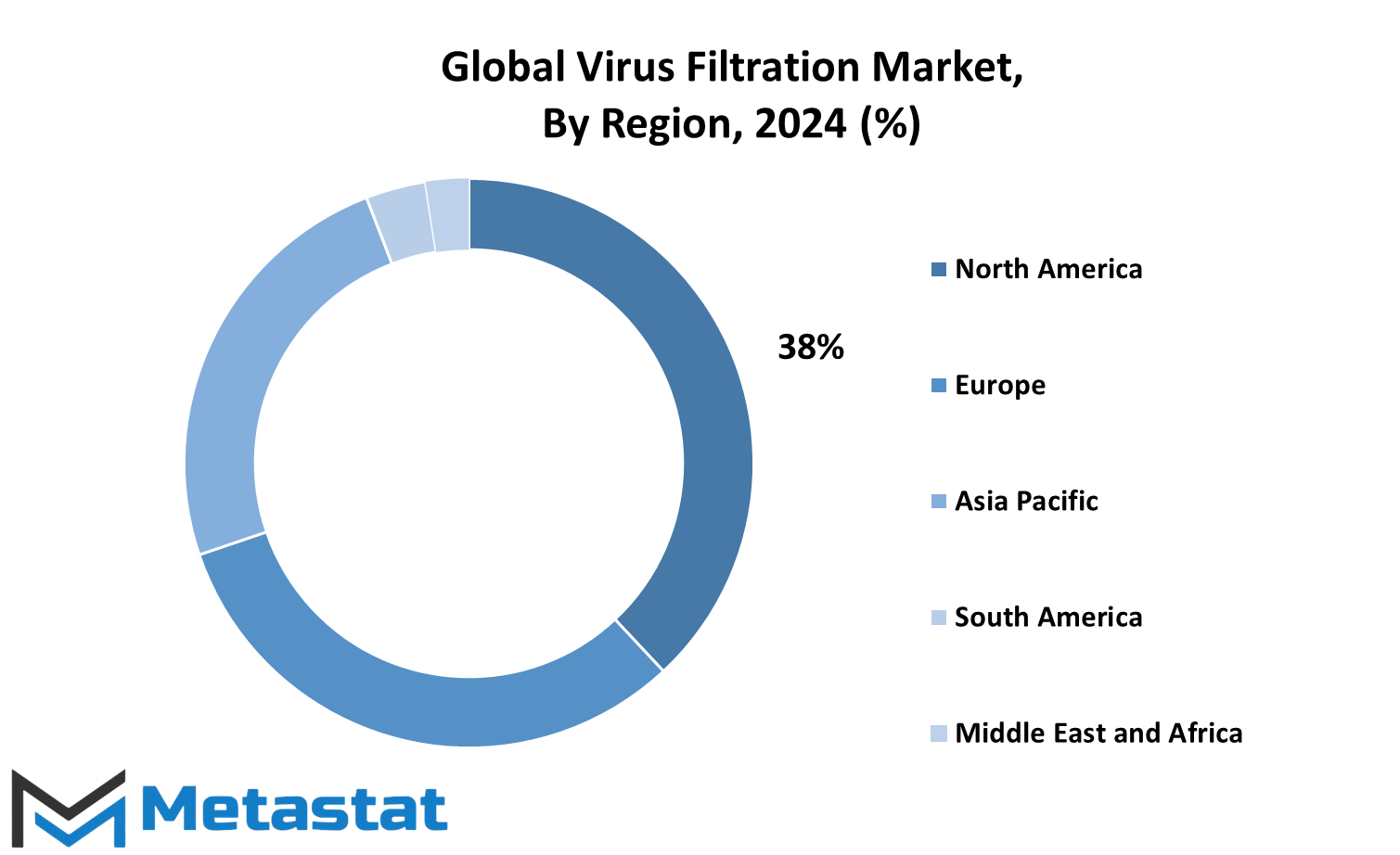
COMPETITIVE PLAYERS
The Global Virus Filtration market has seen significant growth in recent years, driven by increasing awareness of the importance of virus filtration across various sectors. These sectors range from pharmaceuticals and biotechnology to food and beverage industries, as well as water treatment. Virus filtration is crucial for ensuring the safety and purity of products, particularly in industries where contaminants can cause severe harm to consumers or patients. The market's future prospects look promising, with ongoing technological advancements and an increasing demand for high-quality filtration solutions.
The competition in the Global Virus Filtration market is fierce, with numerous key players striving to maintain or grow their market share. Merck KGaA, Pall Corporation, Sartorius AG, and GE Healthcare Life Sciences are among the leading companies that have developed innovative products and technologies to meet the growing demand for virus filtration. These companies have established themselves as key players through extensive research and development, partnerships, and global distribution networks. They provide solutions that cater to a variety of industries, including pharmaceuticals, biopharmaceuticals, and food and beverage.
Merck KGaA, for instance, offers a broad range of virus filtration products designed to enhance the safety of vaccines, biologics, and other pharmaceutical products. Pall Corporation, under the umbrella of Danaher Corporation, is known for its filtration systems that help ensure the sterility of drugs and biologics. Sartorius AG and Thermo Fisher Scientific are also key players in the market, offering advanced filtration technologies for various applications in medical and industrial sectors.
The competition extends beyond these global giants to include specialized companies like 3M Company, Asahi Kasei Corporation, and Repligen Corporation. These companies have developed cutting-edge filtration materials and systems, including novel membrane filters and high-performance filtration devices. Their ability to innovate and cater to specific market needs will continue to drive their success in the market.
With the growing importance of environmental sustainability, companies such as Veolia Water Technologies and DuPont de Nemours are focusing on eco-friendly filtration solutions. Veolia, for example, has been at the forefront of water treatment technologies that include virus filtration systems to protect public health. DuPont de Nemours is advancing the use of sustainable materials in virus filtration, contributing to the market's evolution.
The future of the Global Virus Filtration market looks set to be shaped by continuous technological advancements and the increasing need for safety and reliability in industries that require virus-free products. As new viruses and pathogens emerge, the demand for sophisticated filtration solutions will grow, encouraging more competition and innovation within the market. Companies will increasingly focus on improving the efficiency of filtration methods, reducing costs, and offering more versatile solutions that cater to a wide range of applications. This competitive landscape is expected to drive further growth and transformation in the Global Virus Filtration market in the years ahead.
Virus Filtration Market Key Segments:
By Technology
- Membrane Filtration
- Depth Filtration
- Ultrafiltration
- Nanofiltration
- Microfiltration
- Virus Inactivation
- Adsorption-Based Filtration
By Application
- Pharmaceutical and Biopharmaceutical Manufacturing
- Water and Wastewater Treatment
- Blood and Blood Products Processing
- Food and Beverage Processing
- Air Filtration in Cleanrooms
- Laboratory Filtration
- Vaccine Production
By End User
- Pharmaceutical Companies
- Biotech Companies
- Research Laboratories
- Hospitals and Clinical Laboratories
- Water Treatment Facilities
- Food and Beverage Manufacturers
- Contract Manufacturing Organizations (CMOs)
Key Global Virus Filtration Industry Players
- Merck KGaA
- Pall Corporation (Danaher Corporation)
- Sartorius AG
- GE Healthcare Life Sciences
- 3M Company
- Asahi Kasei Corporation
- Repligen Corporation
- Bio-Rad Laboratories
- Thermo Fisher Scientific
- Parker Hannifin Corporation
- Tetra Pak International S.A.
- Veolia Water Technologies
- DuPont de Nemours, Inc.
- Graver Technologies, LLC
WHAT REPORT PROVIDES
- Full in-depth analysis of the parent Industry
- Important changes in market and its dynamics
- Segmentation details of the market
- Former, on-going, and projected market analysis in terms of volume and value
- Assessment of niche industry developments
- Market share analysis
- Key strategies of major players
- Emerging segments and regional growth potential



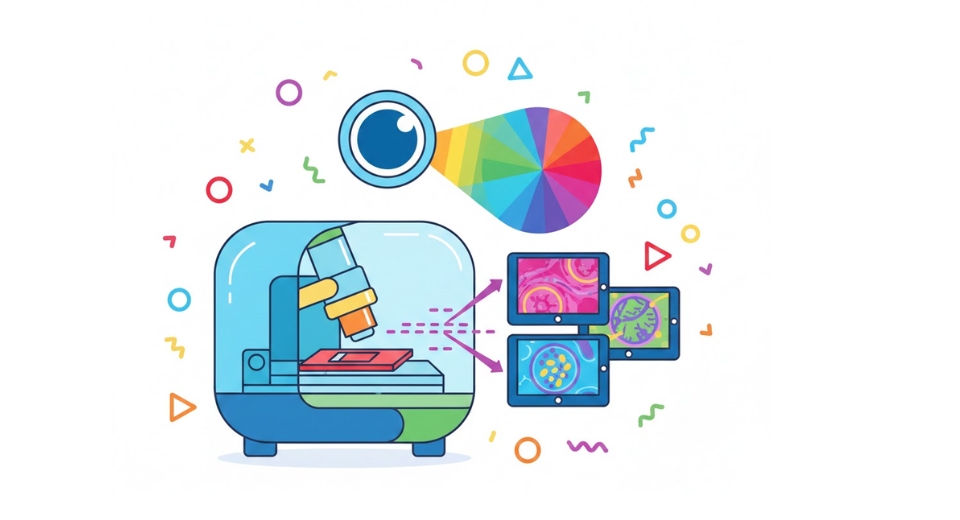
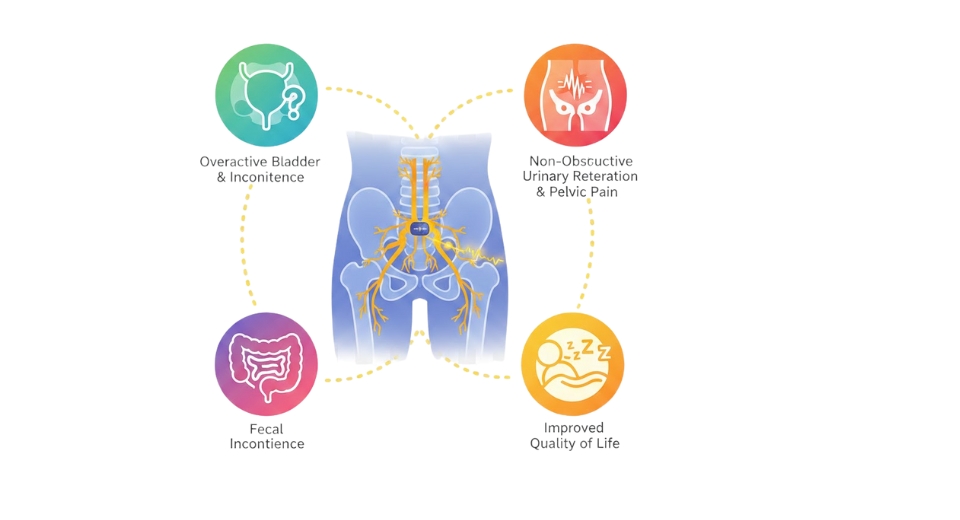
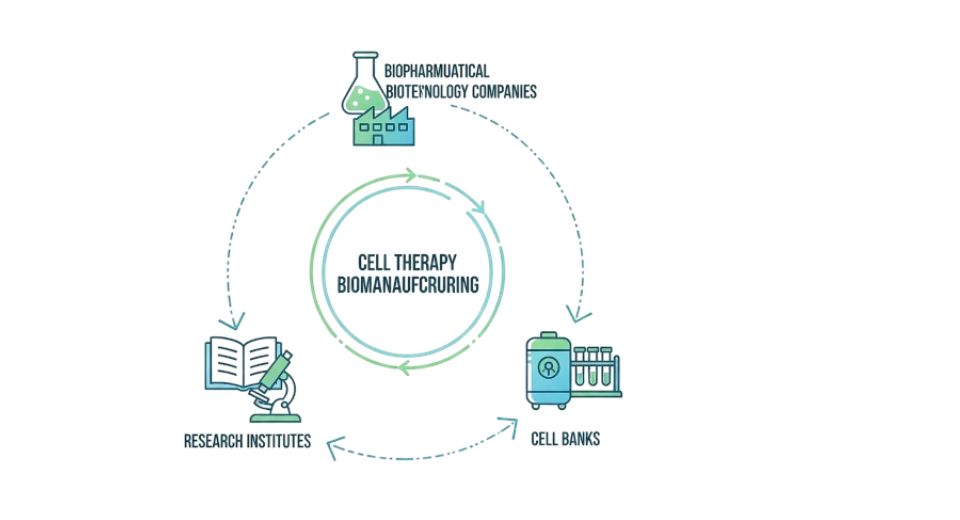
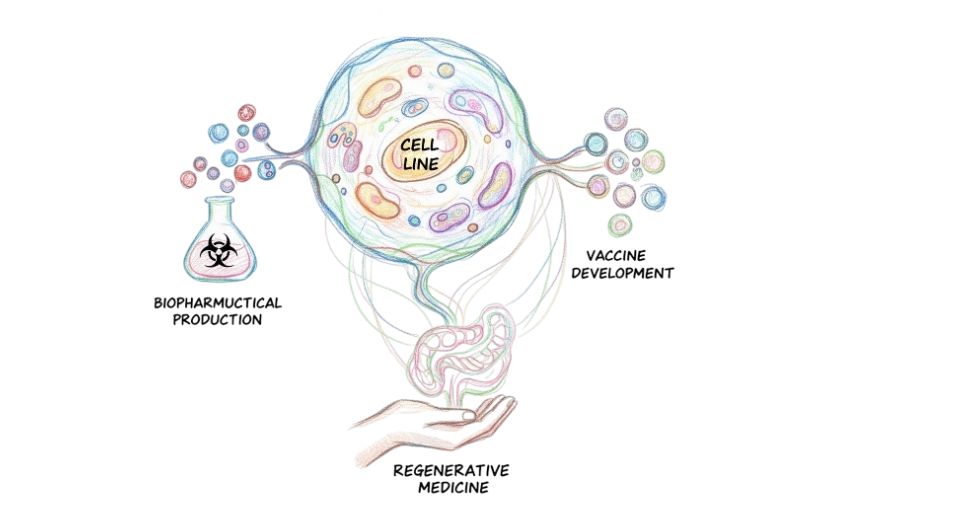

 US: +1 3023308252
US: +1 3023308252






